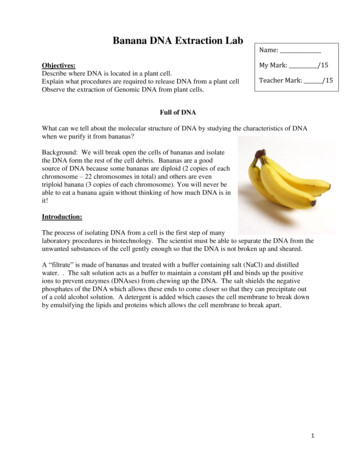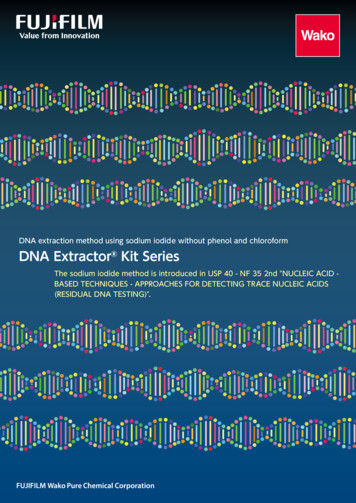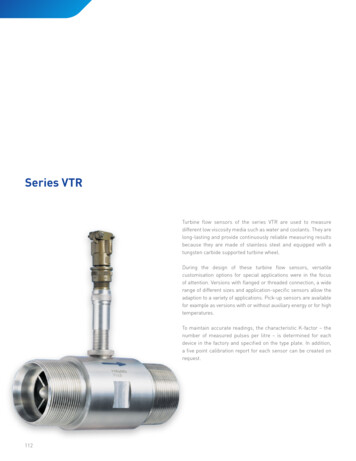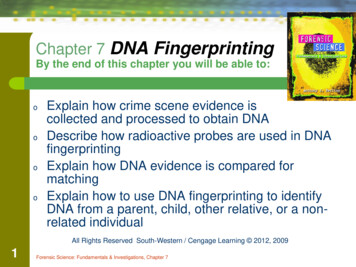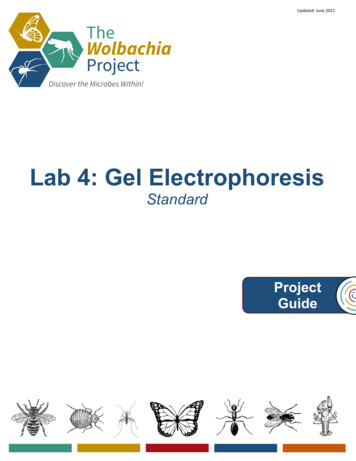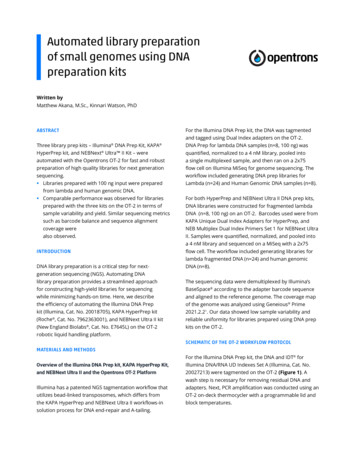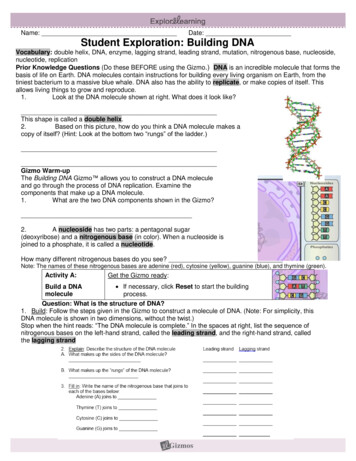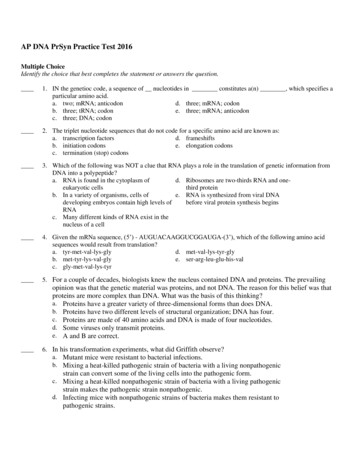
Transcription
Basic DNA Measurement by Flow CytometryIan Brotherick, PhDDNA, or deoxyribonucleic acid, is the molecule that carries the genetic information forall living organisms and is the main constituent of chromosomes. DNA is made froma discrete number of chemical building blocks, or bases, which combine to form twostrands arranged as a double helix. Existing mainly in the cell nucleus, DNA is importantin cell reproduction, cell life and cell death. Consequently, DNA has proved to be ofinterest to flow cytometrists, both in research and clinical fields.DNA ProbesIn order to measure DNA by flow cytometry, it is first necessary to stain or label the DNAwith a fluorescent probe. Unlike those fluorochromes used on labeled antibodies, DNAprobes fluoresce more when bound to their target molecule. The base-probe bond isnot as strong as that of antibody to antigen, and the DNA probe is, consequently, inequilibrium with the free probe in solution. Changes in probe concentration, by dilution ofthe sample, for example, can therefore, influence the fluorescence intensity of the DNAdue to the change in equilibrium. For this reason, DNA preparations are not washed toremove unbound probe; otherwise the equilibrium will be upset. Fortunately, the unboundprobe does not fluoresce and, hence, demonstrates low background fluorescence.The DNA labeling fluorochrome usually intercalates between the bases in doublestranded nucleic acids. However, such fluorochromes can also stain double strandedRNA, which should be eliminated by addition of RNAase to the cell preparation in orderto obtain good results. Single stranded nucleic acids do not stain.The key feature of DNA probes is that they are stoichiometric. This means that thenumber of molecules of probe bound to DNA is equivalent to the number of moleculesof DNA present. Consequently, the amount of emitted light is proportional to the amountof bound probe and, therefore, the amount of DNA.Generally, the DNA probes belong to the family of chemicals broadly known as thephenanthridiniums (includes propidium iodide and ethidium bromide). They generallyexcite in the ultraviolet or blue part of the spectrum and show red spectral emission.Table 1 demonstrates the properties of some of the commonly used DNA probes. A morecomprehensive list may be found in Flow Cytometry: First Principles by A.L.Givan.1Table 1. Common DNA ProbesProbeExcitationEmissionPropidium Iodide536 nm (488 nm laser)623 nmDAPI359 nm (UV laser)461 nmDRAQ5650 nm (488 nm or 633 nm laser)680 nmHoescht346 nm (UV laser)460 nm99
Guide to Flow CytometryTerminologyIn order to effectively measure DNA, it is first necessary to become familiar with someof the terms employed in DNA analysis.Cell CycleMost cells regenerate to replace dead or damaged cells or to grow. In order to grow,the cell doubles its DNA content. The DNA forms two sets of chromosomes, whichline up on spindles within the cell before the cell divides into two equal halves. At onetime point in this process, prior to cell division, or mitosis, the cell will contain twice thenormal amount of DNA. The normal amount of DNA is referred to as diploid or 2n.The cell cycle is generally split into three identifiable component parts by the flowcytometrist (Figure 1). These are the G0G1, S and G2M phases of the cell cycle. Morecorrectly, G0 is a phase where cells are quiescent and not taking part in cell division.G1 is the phase where cells are gearing up to move through cell division. As both ofthese components of the cell cycle have 2n DNA, these phases are not distinguishablefrom each other using solely a DNA probe. S phase is that part of the cell cycle wheresynthesis of DNA occurs and where DNA staining increases. G2 and M phases of thecell cycle are where 4n DNA is present, just prior to and during mitosis, respectively.Again, with just a DNA probe, these two phases are not distinguishable from each otherby the flow cytometer.Figure 1. The cell cycle is generally split into three identifiable component parts by the flow cytometrist: G0G1, S andG2M phases of the cell cycle.This single-parameter histogram (Figure 2) shows fluorescence on a linear scale alongthe x-axis with number of events up the y-axis. Linear is chosen for fluorescence whenexamining DNA. This allows the ready determination of DNA index values, or ratiosbetween peaks. Also, in cases where euploid and aneuploid cells are mixed, it aidsidentification of which G0G1 belongs to which G2M.100
Basic DNA Measurement by Flow CytometryFigure 2. This single-parameter histogram identifies populations in the various stages of cell cycle.PloidyThe ploidy of a cell is an indication of the number of chromosomes in that cell. Eachspecies has a different ploidy value. There can also be variations within an individualpopulation due to mutations, natural multiploidy (plants), certain diseases (includingcancer) and apoptosis. The flow cytometrist tries to define these different ploidy levelsand may use a series of definitions and terms.1. Diploid: The normal (euploid) 2n number of chromosomes. This is the number ofchromosomes in a somatic cell for a particular species.2. Haploid: Half the normal 2n number of chromosomes, or 1n. This is thenumber of chromosomes in a gamete or germ cell (sperm/egg). Again, this isspecies‑dependent.3. Hyperdiploid: Greater than the normal 2n number of chromosomes.4. Hypodiploid: Less than the normal 2n number of chromosomes.5. Tetraploid: Double the normal 2n number of chromosomes, or 4n.6. Aneuploid: An abnormal number of chromosomes.Sample PreparationIn order to successfully measure DNA by flow cytometry, the following issues mustbe addressed.Single-Cell SuspensionCertain cell types naturally lend themselves to flow cytometric analysis, coming in a premade solution as a single-cell suspension (e.g. blood). However, this does not precludethe use of flow cytometry to determine DNA measurement from solid tissues. It merelylengthens the procedure necessary in order to obtain a single-cell suspension.101
Guide to Flow CytometryMaking single-cell suspensions from solid tissues is usually facilitated by one oftwo methods — mechanical disaggregation (e.g. Dako Medimachine) or enzymaticdisaggregation (collagenase, hyaluronidase). Both methods have their advantages anddisadvantages. Mechanical methods are usually quicker and tend not to be so harshthat they strip antigens from the cell membrane. Furthermore, mechanical techniquesmean that the cell can be kept cold and, therefore, better preserved. For enzymaticmethods to work effectively, temperatures must normally be around 37oC, often forseveral hours. During this time, cell viability may decrease. Conversely, there may bemore shear damage from mechanical techniques. However, mechanical techniquesusually process the entire tissue, whereas enzymatic techniques may leave behindundigested tissue, which can potentially contain cells of interest.DNA ProbesAn important point is to check the excitation and emission spectra of the chosen probe(Table 1) and make sure the flow cytometer has the correct laser to excite the probeand the correct filters to detect the emission spectra. Most bench-top instruments andsome cell sorters tend not to have powerful UV lasers, effectively reducing the numberof probes available for use as DNA probes.Cell PermeabilizationAlso, as most DNA is located in the cell nucleus, it is necessary to get the DNA probeinto the nucleus. This may be done in several ways, with varying degrees of harshness,depending on what the final measurement aims are. The treatments usually involveaddition of detergents (Saponin, Triton X-100, Nonidet) or alcohol (ethanol, methanol)to the cells. Permeabilizing the cell membrane with, for example, low levels of saponin,2enables DNA measurement while maintaining cell surface labelling. Use of Triton X-100can strip away the cell membrane and cytoplasm, leaving bare nuclei but giving tightDNA peaks. Alcohol permeabilization is also a popular technique, particularly whenmeasuring nuclear antigens in combination with a DNA probe. Some DNA probesactually enter the cell without need for permeabilization (DRAQ5 and Hoescht). Cellshave the ability to remove chemicals from their interior by membrane pumps, which arebelieved to be the cause of multi-drug resistance in cancer patients. For more in-depthdiscussions on permeabilization, see M. Ormerod’s book, Flow Cytometry.3DNA StabilityIntroducing detergents or alcohol can lead to loss of antigens and more rapid DNAdegradation. Introduction of a fixative (e.g. acetone, formaldehyde) helps stabilizethe cell. However, fixation can also lead to protein conformational changes and DNAcondensation, resulting in reduced antigen and DNA fluorescence profiles.4102
Basic DNA Measurement by Flow CytometryDoublet DiscriminationOne problem that must be overcome when obtaining results for DNA analysis isthe exclusion of clumps of cells. On a flow cytometer, two cells stuck together mayregister as a single event, known as a doublet. If each of those two cells is diploid (2n),seen as one event, they have 4n DNA. In other words, they have the same amount ofDNA as a tetraploid cell (GoG1), or the same amount as a normal cell that is about todivide (G2M). To add to the confusion, further peaks may exist for three or more cellsstuck together.The doublet problem is resolved by employing a doublet discrimination gate based on thecharacteristics of fluorescence height, fluorescence area and signal width. Fluorescenceheight is the maximum fluorescence given out by each cell as it travels through the laserbeam; fluorescence area is the total amount of fluorescence emitted during the samejourney; and signal width is the time a cell takes to pass through the laser beam. Thesecharacteristics are different for a cell that is about to divide when compared to two cellsthat are stuck together (doublets shown in Figure 3). A dividing cell does not double itsmembrane and cytoplasmic size and, therefore, passes through the laser beam morequickly than two cells stuck together. In other words, it has a smaller width signal or abigger height signal but the same area as two cells stuck together. Also, all of the DNA inthe dividing cell is grouped together in one nucleus and consequently gives off a greaterintensity of emitted fluorescence, compared with the DNA in two cells that are stucktogether. Thus, a doublet, which has two nuclei separated by cytoplasm, emits a lowerintensity signal over a longer period. This appears as a greater width signal, lower heightsignal and the same area. These differences can be seen on histograms of FL2-Area vs.FL2-Width or FL2-Area vs FL2 Height, allowing the generation of gates to excludedoublets from sample analysis for both diploid and aneuploid cells.G1G22 x G1Figure 3. Doublet discrimination is possible based on fluorescence height, fluorescence area and signal width.103
Guide to Flow CytometryInstrument SetupInstrument setup varies with manufacturer. However, there are some general principlesto observe.1. Select the LIN channel that is most appropriate for the DNA probe.2. Set the trigger on the channel detecting the DNA probe, as light scatter parametersare not usually of much use for triggering in the case of DNA.3. Select parameters to enable doublet discrimination.4. Set a gate to exclude doublets and apply it to the histogram that will displaythe DNA profile. Displaying an ungated plot of the same may data may alsobe useful.5. Make sure the sheath tank is full, as it may help with stability.6. Make sure the cytometer is clean. Stream disruption will increase the CV.7. Set a low flow rate and dilute cells to a concentration that is appropriate for theDNA probe solution.8. Make sure the instrument has been optimized by running routine calibrationparticles.StandardizationRunning daily alignment checks and passing standard quality control proceduresshould mean the instrument is capable of good DNA profiles. Further DNA standardsare available and include trout and chicken erythrocyte nuclei as indicators of DNAploidy. Tumor samples normally contain diploid cells that can be used as an internalstandard. For aneuploid cell lines, spiking samples with known diploid cells can helpwith DNA index determination.5-6Data Analysis and ReportingAttempts have been made to standardize the generation of DNA flow cytometry results,both in reporting for clinical use and for publication of research data. These attemptshave resulted in several articles, based on cell type.7-11 However, some general guidelinesare as follows.1. Determine the cell ploidy and report the DNA index of all ploidy populations.2. Report the CV of the main G0G1 peak. Generally, less than 3 is good; greater than8 is poor.3. When measuring the S-phase fraction (SPF) of a diploid tumor, make a statementas to whether the S-phase was measured on the whole sample, including normalcells, or on the tumor cells alone, gated by tumor-specific antibody.104
Basic DNA Measurement by Flow Cytometry4. Add a brief comment if necessary to cover any other information that may behelpful to someone looking at the result (e.g. inadequate number of cells, highdebris levels, high CV, % background, aggregates and debris).Not all attempts at DNA measurement will be successful. Methodological, sampleand instrument issues may mean some of the DNA information is not suitable forinterpretation and use in publications. Generally, a result should be rejected if any ofthe following apply:1. CV of the G0G1 peak is greater than 8%.2. Sample contains less than 10,000 to 20,000 nuclei.3. Data contains more than 30% debris.4. Flow rate was too high, as indicated by a broad CV or curved populations ontwo-parameter plots.5. G0G1 peak isn’t in channel 200 of 1024 or 100 of 512 (i.e. on a suitable scale ina known channel).6. Fewer than 200 cells in S-phase (if SPF is to be reported).7. G0G1 to G2M ratio is not between 1.95 and 2.05.DNA and BeyondHaving mastered simple DNA applications, the cytometrist may incorporate theminto more complex protocols. Combinations of surface, cytoplasmic and nuclearmarkers allow the cytometrist to explore chromosomes, apoptosis, cell doubling timesand beyond.References1.2.3.4.5.6.7.Givan AL. Flow cytometry: first principles. 2nd ed. New York: Wiley, John & Sons,Inc; 2001.Rigg KM, Shenton BK, Murray IA, Givan AL, Taylor RMR, Leonnard TWJ. A flowcytometric technique for simultaneous analysis of human mononuclear cell surfaceantigens and DNA. J Immunol Methods 1989;123:177.Ormerod MG, editor. Flow cytometry. 3rd ed. Oxford: Oxford University Press; 2000.Larsen JK. Measurement of cytoplasmic and nuclear antigens. In: Ormerod MG.Flow cytometry. 3rd ed. Oxford: Oxford University Press; 2000.Shankey TV, Rabinovitch PS, Bagwell B, Bauer KD, Duque RE, Hedley DW, et al.Guidelines for implementation of clinical DNA cytometry. Cytometry 1993;14:472.Ormerod MG, Tribukait B, Giaretti W. Consensus report of the task force onstandardisation of DNA flow cytometry in clinical pathology. Anal Cell Path1998;17:103.Bauer KD, Bagwell CB, Giaretti W, Melamed M, Zarbo RJ, Witzig TE, et al.Consensus review of the clinical utility of DNA flow cytometry in colorectal cancer.Cytometry 1993;14:486.105
Guide to Flow Cytometry8.Duque RE, Andreeff M, Braylan RC, Diamond LW, Peiper SC. Consensus review ofthe clinical utility of DNA flow cytometry in neoplastic hematopathology. Cytometry1993;14:492.9. Hedley DW, Shankey TV, Wheeless LL. DNA cytometry consensus conference.Cytometry 1993;14:471.10. Hedley DW, Clark GM, Cornelisse CJ, Killander D, Kute T, Merkel D. Consensus review ofthe clinical utility of DNA cytometry in carcinoma of the breast. Cytometry 1993;14:482.11. Shankey TV, Kallioniemi OP, Koslowski JM, Lieber JL, Mayall BH, Miller G, et al.Consensus review of the clinical utility of DNA content cytometry in prostate cancer.Cytometry 1993;14:497.12. Wheeless LL, Badalament RA, deVere White RW, Fradet Y, Tribukait B. Consensus reviewof the clinical utility of DNA cytometry in bladder cancer. Cytometry 1993;14:478.106
Certain cell types naturally lend themselves to flow cytometric analysis, coming in a pre-made solution as a single-cell suspension (e.g. blood). However, this does not preclude the use of flow cytometry to determine DNA measurement from solid tissues. It merely lengthens the procedure necessary in order to obtain a single-cell suspension.
